Amy Starecheski describes how Mott Haven Oral History Project worked with Cortico’s Local Voices Network (LVN) to capture the impact of activists working for immigrant rights and mutual aid during COVID, to hold government accountable for environmental justice, and to address the impact of mass incarceration on their community
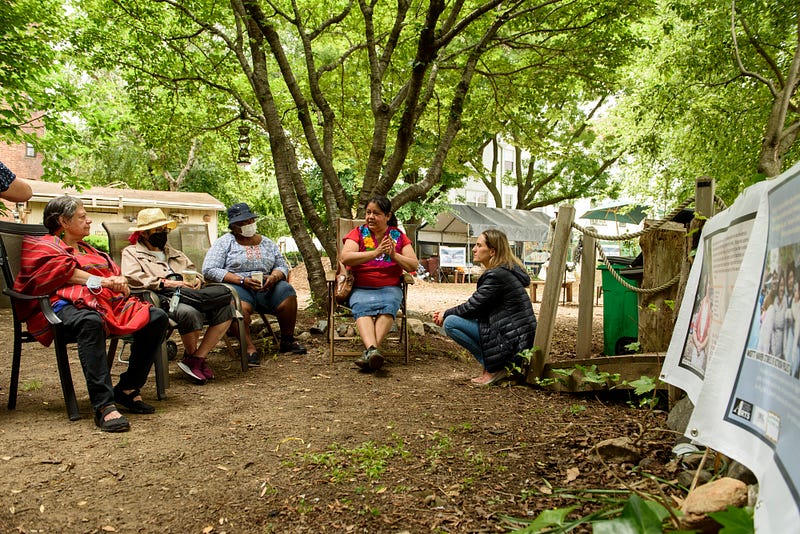
The Mott Haven Oral History Project documents the history of Mott Haven — a mile-square neighborhood in the South Bronx — through the voices of people who have lived it. The project exists to record, share, and amplify the stories and analysis of Mott Haven residents. We are working with and making meaning from these stories as we record them, doing this work together and in public, initially through projects like our oral history walk, listening party, banners, and storymap.
In the fall of 2019, our team prepared to launch an oral history listening project that would be installed on public buses, with support from the Bronx Council on the Arts. Then, we all stopped riding buses if we could help it. As the pandemic ground forward, we needed to find another way to gather and share oral history — and decided to focus on collecting stories from local activists. Through their Local Voices Network, Cortico supported us in this work, elevating these under-heard voices throughout the borough and beyond.
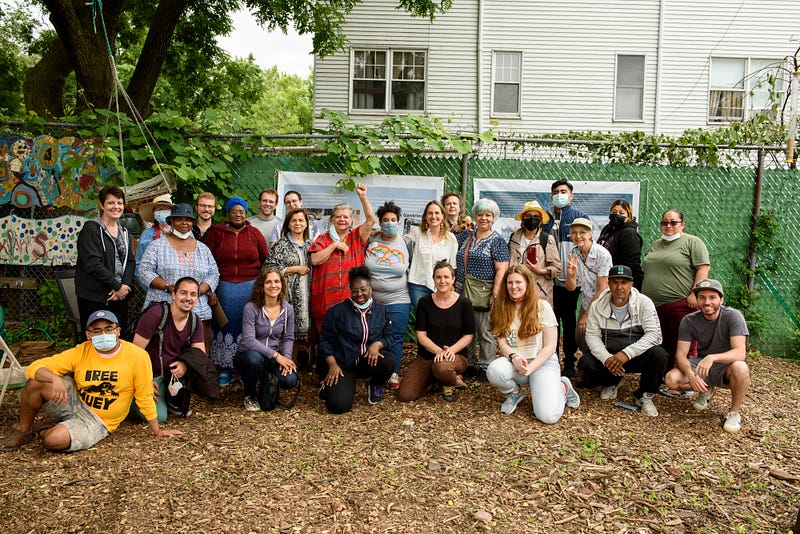
Group conversations, mainly held online, documented stories of activism in our community. Cortico’s team worked with us to create an interview guide and consent materials tailored to our project. Members of our organization’s collaborative team chose a story to document, invited participants, and recorded a conversation on Zoom or in person. Then, we worked to share these stories back to the community through interactive in-person and online resources.
Romina Hendlin focused on the work of the Saavedra family, who own La Morada, a restaurant that transformed into a mutual aid kitchen during the pandemic and is an anchor for Mott Haven. They have been prominent activists for years, especially around immigrant rights. Romina interviewed them about their family history, and learned how the children have inspired the parents as well as how the parents have supported the children.

Carol Zakaluk wanted to hear from people who have organized to demand waterfront access for the neighborhood, drawing on her own decades of work on the issue. Representatives from the Cherry Tree Association, Friends of Brook Park, South Bronx Unite, and the New York Restoration Project shared why waterfront access and environmental justice matter to them, documenting the frustrating obstacles to building a long-planned (and funded) waterfront park to benefit residents.

Ramona Ferreyra and Olivia Glover chose to focus on the history of Mott Haven activism to address mass incarceration, and the history of borough-based jails in the Bronx. The conversation aimed to explore perspectives on a new jail that has been planned to open in our borough, reflecting voices of those who support and those who oppose the project. In their research, Ramona and Olivia found that a Bronx County Jail had previously been located in Mott Haven. Folks from Bronx Connect, Freedom Agenda, Children’s Haven, and Mott Haven Reformed Church participated — representing those who support the jail. Due to the the still-contentious nature of this issue folks who oppose the jail did not join this conversation. There is more work to be done to tell the stories and histories of those who oppose the jail, and it is work we are eager to do.

Cortico technology and transcriptions allowed us to share excerpts from these conversations with a broader public. In the past, to make clips we had literally clipped the piece of audio right out of the interview — but LVN’s highlights feature allowed us to share pieces that stayed embedded within the full public interview, which served our goal of enticing people to listen deeply to their neighbors.
In keeping with our broader goal of amplifying oral histories in public space, we decided to make a series of large banners — highlighting and illustrating the oral history we collected. By the time they were done, enough people were vaccinated in NYC that we were able to hold an in-person launch party at a local community garden. We were easily able to download clips from LVN to play on bluetooth speakers. Each team member set up a station with their banners and facilitated conversations with visitors about the stories they’d recorded, using clips from the interviews.
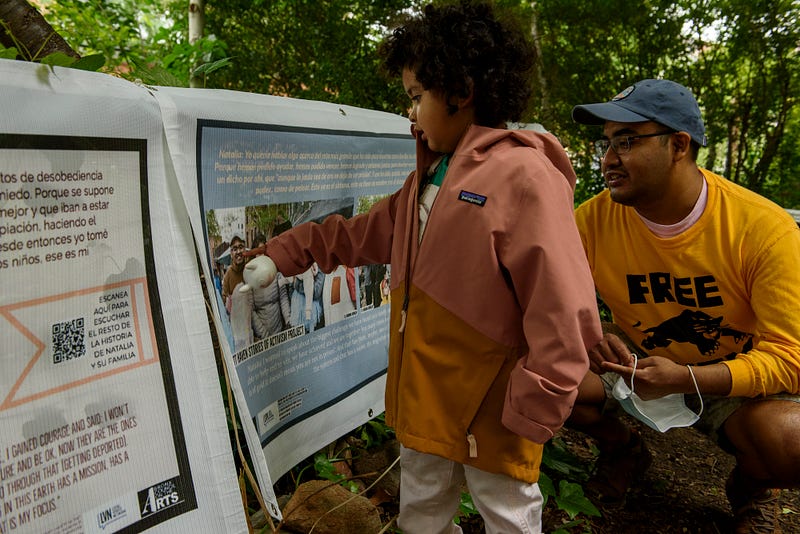
It was exciting to witness the activism continuing through this event, as folks scanned QR codes that took them to action items such as signing a petition. The waterfront access banner drew the attention of a liaison to our Congressmen, who vowed to carry what he learned about the stalemated park back to someone with clout. The liaison was also personally acquainted with one of the activists speaking in the clips, and said he’d be sure to follow up with her on details.
After cake and Oaxacan food and lots of conversation, we walked together to sites around the neighborhood to hang up the banners. People who had been interviewed helped to hang them, and talked to groups on the sidewalk about what their stories mean to them, and their hopes for the neighborhood’s future.
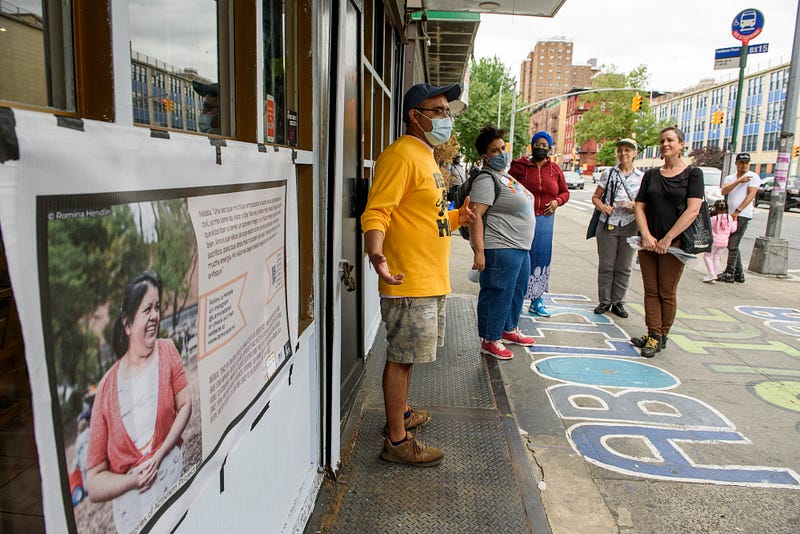
Our team and our community ended this phase of work excited to continue partnering with Cortico to document our neighborhood’s activist history.
To learn more about this project, read about it on our website or view our StoryMap, which integrates LVN highlights into free software from Knight Lab — providing an online version of the banners, extending our story beyond the streets of our neighborhood.
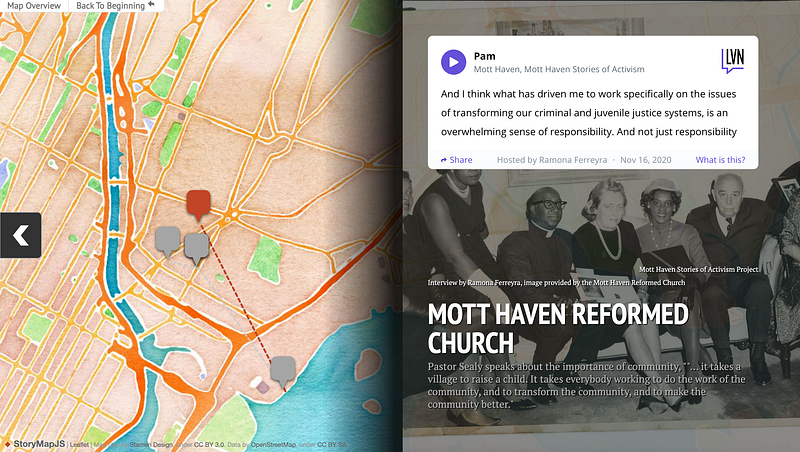
Amy Starecheski is an oral historian, cultural anthropologist and long-time resident of Mott Haven who founded the Mott Haven Oral History Project. Today, the Project works as a team to collectively shape their project goals. Amy teaches oral history at Columbia University and has a PhD from the CUNY Grad Center.
